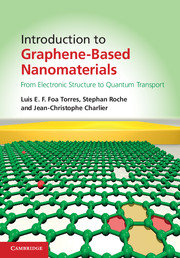Book contents
- Frontmatter
- Contents
- Preface
- 1 Introduction to carbon-based nanostructures
- 2 Electronic properties of carbon-based nanostructures
- 3 Quantum transport: general concepts
- 4 Klein tunneling and ballistic transport in graphene and related materials
- 5 Quantum transport in disordered graphene-based materials
- 6 Quantum transport beyond DC
- 7 Ab initio and multiscale quantum transport in graphene-based materials
- 8 Applications
- Appendix A Electronic structure calculations: the density functional theory (DFT)
- Appendix B Electronic structure calculations: the many-body perturbation theory (MBPT)
- Appendix C Green's functions and ab initio quantum transport in the Landauer–Büttiker formalism
- Appendix D Recursion methods for computing the DOS and wavepacket dynamics
- References
- Index
8 - Applications
Published online by Cambridge University Press: 05 February 2014
- Frontmatter
- Contents
- Preface
- 1 Introduction to carbon-based nanostructures
- 2 Electronic properties of carbon-based nanostructures
- 3 Quantum transport: general concepts
- 4 Klein tunneling and ballistic transport in graphene and related materials
- 5 Quantum transport in disordered graphene-based materials
- 6 Quantum transport beyond DC
- 7 Ab initio and multiscale quantum transport in graphene-based materials
- 8 Applications
- Appendix A Electronic structure calculations: the density functional theory (DFT)
- Appendix B Electronic structure calculations: the many-body perturbation theory (MBPT)
- Appendix C Green's functions and ab initio quantum transport in the Landauer–Büttiker formalism
- Appendix D Recursion methods for computing the DOS and wavepacket dynamics
- References
- Index
Summary
This section presents a brief overview of the most promising graphene applications in information and communication technologies, reflecting current activities of the scientific community and the authors' own views.
Introduction
The industrial impact of carbon nanotubes is still under debate. Carbon nanotubes exist in two complementary flavors, i.e metallic conductors and semiconductors with tunable band gap (scaled with tube diameter), both exhibiting ballistic transport. This appears ideal at first sight for creating electronic circuits, in which semiconducting nanotubes (with diameter around 1–2 nm) could be used as field effect transistors, whereas metallic single-wall tubes (or large-diameter multiwalled nanotubes), with thermal conductivity similar to diamond and superior current-carrying capacity to copper and gold, would offer ideal interconnects between active devices in microchip (Avouris, Chen & Perebeinos, 2007). Nanotube-based interconnects have been physically studied over almost a decade, with companies such as Samsung, Fujitsu, STMicroelectronics, or Intel acting significantly or encouraging academic research (Coiffic et al., 2007). The current-carrying capability of bundles of multiwalled nanotubes has been practically demonstrated to fulfill the requirements for technology and thus could replace metals (Esconjauregui et al., 2010), although a disruptive technology step remains to be achieved to integrate chemical vapor deposition (CVD) growth at the wafer-scale, a step of no defined timeline.
- Type
- Chapter
- Information
- Introduction to Graphene-Based NanomaterialsFrom Electronic Structure to Quantum Transport, pp. 300 - 313Publisher: Cambridge University PressPrint publication year: 2014



